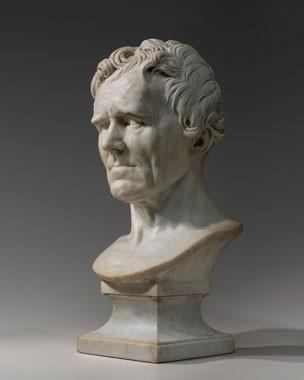
Pierre-Jean David d'Angers, Comte Boulay de la Meurthe, 1832. Marble. 70 cm (27 1/2 in.) with base. National Gallery of Art, Washington. Patrons’ Permanent Fund and the Buffy and William Cafritz Family Sculpture Fund.
Washington, DC—The National Gallery of Art announced on December 19th the acquisition of a major portrait bust by one of the most renowned sculptors of the Romantic era, Pierre-Jean David d'Angers (1788–1856). David d'Angers's public monuments and portraits of intellectuals and political figures capture the charged spirit of the epoch like no others. Purchased with funds from the Patrons' Permanent Fund and the Buffy and William Cafritz Family Sculpture Fund, the larger-than-life Comte Boulay de la Meurthe (1832) is among the finest portrait busts by David d'Angers anywhere and the first marble by the sculptor to enter the Gallery's collection. It is on view on the main floor of the West Building, Gallery 56.
"We are delighted to acquire this masterpiece of 19th-century French sculpture with its magnificent naturalistic details and colossal scale that capture the expressive force of Romanticism," said Earl A. Powell III, director, National Gallery of Art. "David d'Angers was drawn to individuals such as the Comte Boulay de la Meurthe who embodied ideals of service to humanity and France."
The Gallery owns several examples of David d'Angers's portrait medallions and two small bronze casts of larger sculptures: Thomas Jefferson (model 1832–1833, cast after 1892), which reflects the artist's statue of Jefferson in the rotunda of the United States Capitol, and Ambroise Paré (model 1836–1839, cast after 1840). François-Pascal-Simon, Baron Gérard (1836–c. 1838), a plaster cast by David d'Angers in the Gallery's collection, bears his signature and dedication in black chalk.
Pierre-Jean David d'Angers (1788–1856)
Born to working-class parents in Angers, David d'Angers moved to Paris in 1808 to study sculpture at the École des Beaux-Arts. In 1810, he won second prize in the Prix de Rome competition with an entry that caught the attention of Jacques-Louis David, Napoleon's principal painter. David invited the young sculptor to train in his studio, where David d'Angers learned to practice the unique blend of classicism and sharp naturalism that became a hallmark of his style. He called himself David d'Angers to prevent confusion with his celebrated mentor. After four years in Rome, David d'Angers returned to Paris in 1816 and won several prestigious commissions for public monuments, including the bas-reliefs for the pediment of the Panthéon (1830–1837), which solidified his position as the leading sculptor in Paris.
David d'Angers excelled at portraits. He depicted many of the most important figures in contemporary art and politics, including Johann Wolfgang von Goethe, Thomas Jefferson, Victor Hugo, and Harriet Beecher Stowe. Influenced by the theory of phrenology, which held that a person's appearance reflected emotional and intellectual characteristics, he frequently adjusted his likenesses in order to emphasize those expressive characteristics he associated with his sitters.
Comte Boulay de la Meurthe (1832)
Exhibited at the Salon of 1833 and carved from crystalline marble mined in the Pyrenees, the bust of Comte Boulay de la Meurthe exhibits an extraordinary sensitivity to material. The bust's asymmetrical features—slanting creases in the furrowed brow, cocked right eyebrow, and pull of skin to the right under the chin—are characteristics David d'Angers emphasized to capture the Comte Boulay de la Meurthe's variable temperament. Although David d'Angers typically entrusted his carving to specialists, or practiciens, the many subtleties in the execution testify to his direct work at least on the defining touches.
"A tour de force of naturalism, the bust looks as though it has always been part of our collection, perfectly at home among our great portraits by David and Ingres, where it strikes similar chords of grandeur and psychological presence," said C. D. Dickerson, curator and head of the sculpture and decorative arts department, National Gallery of Art.
Born in the region of Les Vosges in 1761, the Comte Boulay de la Meurthe practiced law in Paris. His stance against the Directory (the French Revolutionary government that held power between November 1795 and November 1799) won him the admiration of Napoleon, who awarded him the Grand Cross of the Légion d'Honneur and invited him to serve on his privy council. He was later appointed president of the commission responsible for drafting France's new constitution and the body of laws otherwise known as the Napoleonic Code. In retirement, in addition to his memoirs, he wrote two books on English history.




























